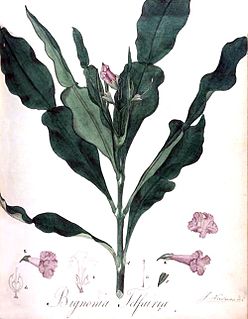Related Research Articles

Catharanthus is a genus of flowering plants in the family Apocynaceae. Like the genus Vinca, they are known commonly as periwinkles. There are eight known species. Seven are endemic to Madagascar, though one, C. roseus, is widely naturalized around the world. The eighth species, C. pusillus, is native to India and Sri Lanka. The name Catharanthus comes from the Greek for "pure flower".

Conyza is a genus of flowering plants in the sunflower family.

Crassocephalum is a genus the common names of whose members include ragleaf, thickhead, and bologi. Several species are raised as leaf vegetables and used for medicine, especially in West Africa. Similar to Senecio, but differing in never having ray florets. A calyculus of short bracts is present. The genus is typically thistle-like in appearance, but all parts are soft and not spiny.

Erythroxylum (Erythroxylon) is a genus of tropical flowering plants in the family Erythroxylaceae. Many of the approximately 200 species contain the substance cocaine; Erythroxylum coca, a native of South America, is the main commercial source of cocaine and of the mild stimulant coca tea. Another species, Erythroxylum vaccinifolium is used as an aphrodisiac in Brazilian drinks and herbal medicine.

Stereospermum is a genus of trees in the paleotropical clade of the family Bignoniaceae. A species of Stereospermum is used in herbal medicine in Ayurveda as well as it is an integral part of the culture and tradition of the cold desert biosphere reserve.

Dombeya is a flowering plant genus. Traditionally included in the family Sterculiaceae, it is included in the expanded Malvaceae in the APG and most subsequent systematics. These plants are known by a number of vernacular names which sometimes, misleadingly, allude to the superficial similarity of flowering Dombeya to pears or hydrangeas. Therefore, the genus as a whole is often simply called dombeyas. The generic name commemorates Joseph Dombey (1742–1794), a French botanist and explorer in South America, involved in the notorious "Dombey affair", embroiling scientists and governments of France, Spain, and Britain for more than two years.

Anisopappus is a genus of flowering plants in the sunflower family.

Hubertia is a genus of flowering plants in the daisy family.
Oliganthes is a genus of flowering plants in the evil tribe within the daisy family.
Syncephalum is a genus of flowering plants in the pussy's-toes tribe within the daisy family.
Rochonia is a genus of Madagascarian plants in the aster tribe within the daisy family.

Markhamia is a genus of flowering plants in the family Bignoniaceae. The genus is named after Clements Markham.
Rauvolfioideae is a subfamily of the flowering plant family Apocynaceae. Many species are woody lianas, others are shrubs or perennial herbs.
Tachiadenus is a plant genus in the gentian family (Gentianaceae), tribe Exaceae. It contains 12 species.
Aphelexis is a genus of flowering plants belonging to the family Asteraceae.
Colea is a genus of flowering plants belonging to the family Bignoniaceae.

Rhodocolea is a genus of flowering plants belonging to the family Bignoniaceae.
References
- ↑ Bojer, Wenceslas ex Candolle, Augustin Pyramus de. 1836. Prodromus systematis naturalis regni vegetabilis, sive, Enumeratio contracta ordinum generum specierumque plantarum huc usque cognitarium, juxta methodi naturalis, normas digesta 5: 93 in Latin
- ↑ Tropicos, Centauropsis Bojer ex DC.
- ↑ Flann, C (ed) 2009+ Global Compositae Checklist